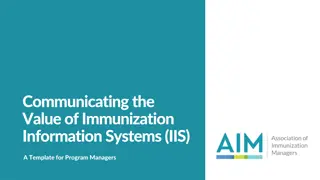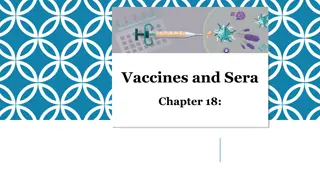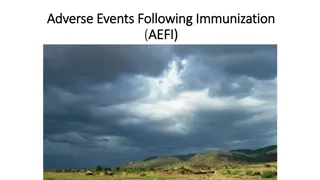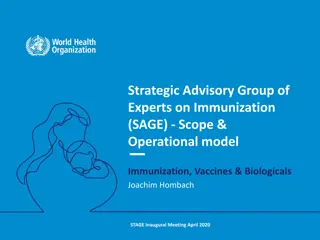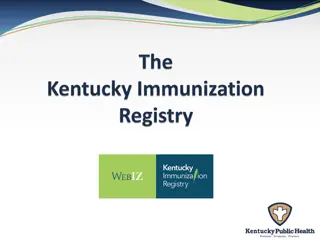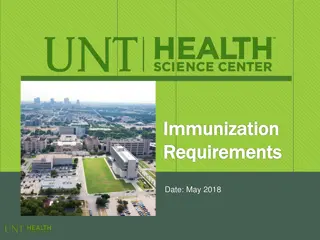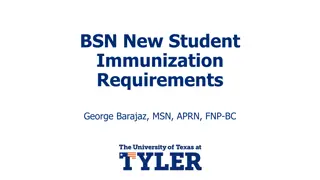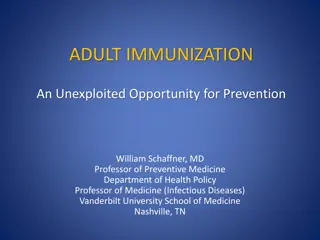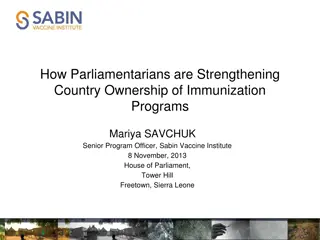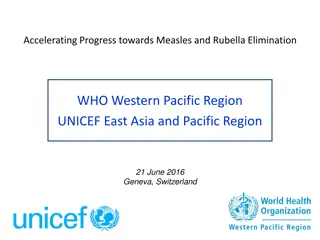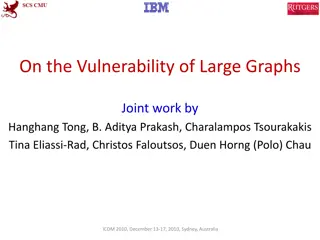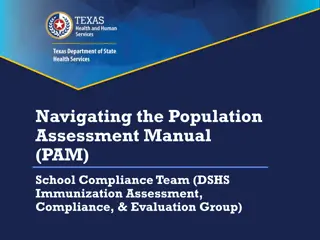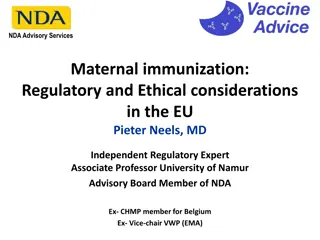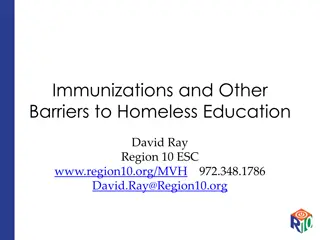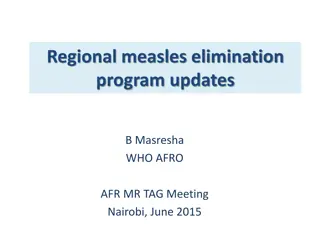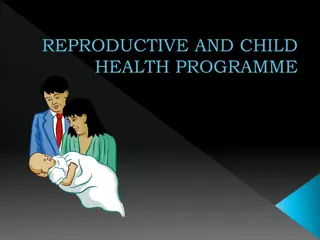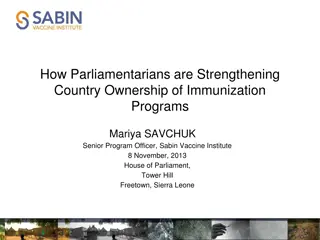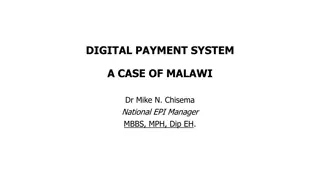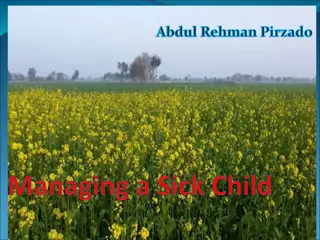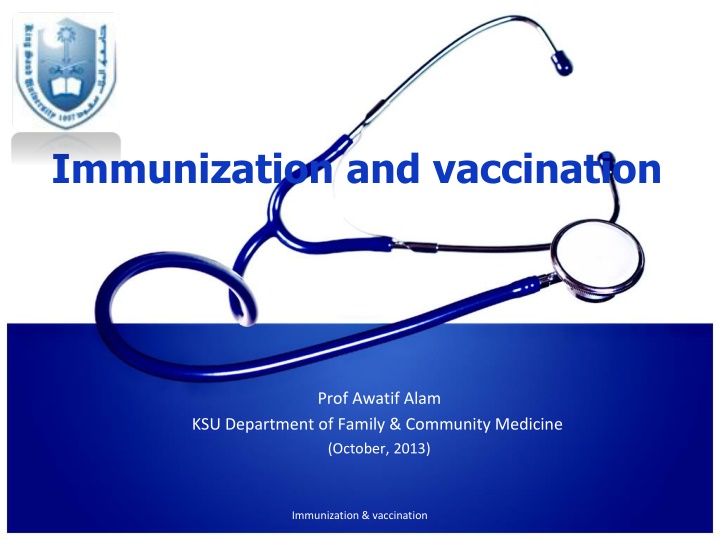
Immunization and Vaccination: Prof. Awatif Alam KSU Department Insights
Explore the world of immunization and vaccination through the expert guidance of Prof. Awatif Alam from the KSU Department of Family & Community Medicine. Uncover the importance of immunity, essential vaccines, and the cold chain in maintaining public health. Discover why immunization is vital in combating communicable diseases and safeguarding well-being.
Download Presentation

Please find below an Image/Link to download the presentation.
The content on the website is provided AS IS for your information and personal use only. It may not be sold, licensed, or shared on other websites without obtaining consent from the author. If you encounter any issues during the download, it is possible that the publisher has removed the file from their server.
You are allowed to download the files provided on this website for personal or commercial use, subject to the condition that they are used lawfully. All files are the property of their respective owners.
The content on the website is provided AS IS for your information and personal use only. It may not be sold, licensed, or shared on other websites without obtaining consent from the author.
E N D
Presentation Transcript
Immunization and vaccination Prof Awatif Alam KSU Department of Family & Community Medicine (October, 2013) Immunization & vaccination
Objectives of the session By the end of the session the students should be able to; Mention types of immunity List important immunizable diseases Describe the compulsory childhood vaccination schedule practiced in KSA Understand the importance of maintenance of the Cold Chain Immunization 2
CONCEPTS Why immunize ? Types of immunity Classes of vaccines KSA Compulsory immunization schedule Female adult immunization Immunization for special occupations The Cold Chain Immunization 3
Why to Immunize? Immunization has helped reduce the impact of communicable disease on health and wellbeing Some diseases have been well controlled and other eliminated from some parts of the world because of vaccination Stopping vaccination may again lead to epidemic WHO-210375 Immunization 4
Acquired immunity Immunity Artificial Natural Passive Active Passive Active (Post-vaccination) (Immune serum) Subclinical Infection Trans- placental Live attenuated Vaccine Homologous Clinical Infection Killed/ Inactivated Heterologous Subunit
The immune system Immunization 7
Types of Immunity 2 Immunity The ability of the human body to tolerate the presence of material indigenous to the body ( self ), and to eliminate foreign ( non self ) material. Active Immunity Passive immunity Protection of persons by their immune system Immuno globulins and immune sera Temporary protection, Usually life-long Wanes with time 8 Immunization
Vaccination A method of giving antigens to stimulate the immune response through active immunization. A vaccine is an immuno-biological substance designed to produce specific protection against a given disease. A vaccine is antigenic but not pathogenic . Immunization 9
Antigens & Antibodies Antigen A live or inactivated substance (e.g., protein, polysaccharide) capable of producing an immune response Antibody Protein molecules (immunoglobulins) produced by B lymphocytes to help eliminate an antigen Immunization 10
Immunotherapy preformed Ab Immune serum globulin (gamma-globulin) contains immunoglobulin extracted from the pooled blood of human donors. Treatment of choice for preventing measles, hepatitis A and replacing Ab in the immune deficient. Lasts 2-3 months.
Immunotherapy preformed Ab Specific convalescent patients in a hyperimmune state Contains high titer of specific Ab. Pertussis, Tetanus, Chickenpox, Hepatitis B. Sera produced in horses are available for Diphtheria, Botulism, Spider and Snake bites. Act immediately and can protect patients for whom no other useful medication exists. immune globulin- prepared from
How vaccines work? Immunization 13
Classification of types of Vaccines Live attenuated Viral Bacterial Inactivated Whole Viral Bacterial Fractional protein-based toxoid subunit polysaccharide-based pure conjugate Immunization 14
Live Attenuated Vaccines Attenuated (weakened) form of the "wild" virus or bacterium Must replicate to be effective Immune response similar to natural infection Usually effective with one dose* Severe reactions are possible Interference from circulating antibodies are possible Fragile must be stored and handled carefully *except those administered orally Immunization 15
Examples of Live Attenuated Vaccines Viral BCG, oral typhoid e.g. measles, mumps, rubella, yellow fever, influenza, oral polio Bacterial Immunization 16
Inactivated Vaccines Cannot replicate Less interference from circulating antibody than live vaccines Generally require 3-5 doses Immune response mostly humoral Antibody titer diminishes with time Immunization 17
Examples of Inactivated Vaccines Viral Inactivated polio vaccine (IPV), Hepatitis A, Influenza, Rabies Bacterial Pertussis, Typhoid, Cholera, Plague Subunit Hepatitis B Toxoid Tetanus, Diphtheria Immunization 18
Cellular fraction (Polysaccharide) vaccines They are prepared from extracted cellular fractions e.g. N. meningitidis (A,C,Y,W-135); meningococcal vaccine from the polysaccharide antigen of the cell wall Strept. Pneumoniae; pneumococcal vaccine from the polysaccharide contained in the capsule of the organism Their efficacy and safety appear to be high. Immunization 19
Conjugate vaccine Haemophilus influenza B (Hib) vaccine; gives long- term protection from Haemophilus influenza type B the leading cause of meningitis in children under 5 years. Immunization 20
Surface antigen (recombinant) vaccines It is prepared by cloning HBsAg gene in yeast cells where it is expressed. HBsAg produced is then used for vaccine preparations. Their efficacy and safety also appear to be high. Immunization 21
Toxoids Prepared by detoxifying the exotoxins of some bacteria rendering them antigenic but not pathogenic. Adjuvant (e.g. alum precipitation) is used to increase the potency of vaccine. The antibodies produced in the body neutralize the toxic part produced during infection rather than act upon the organism itself. In general toxoids are highly efficacious and safe immunizing agents.
Immunization 23
Childhood Immunization Schedule in KSA - 2013 Age: Vaccines: At birth BCG / Hepatitis B 2 Months IPV /DTaP / Hepatitis B/ Hib/Pneumococcal Conjugate (PCV)/Rota 4 Months IPV /DTaP / Hepatitis B/ Hib/Pneumococcal Conjugate (PCV)/Rota 6 Months OPV/IPV /DTaP/ Hepatitis B/ Hib/Pneumococcal Conjugate (PCV) 9 Months Measles / Meningococcal Conjugate quadrivalent (MCV4) 12 Months OPV/ MMR/ Pneumococcal Conjugate (PCV)/Meningococcal Conjugate quadrivalent (MCV4) 18 Months OPV/DTaP/Hib/ MMR/ Varicella/ Hepatitis A 24 Months Hepatitis A First class Primary School age OPV/ DTaP(Td) / MMR/Varicella
Doses & Routes of administration Vaccine Dose Route BCG 0.05 ml ID or SC (left arm) DPT 0.5 ml IM (right or left side of thigh) Hepatitis B (HBV) 0.5 ml IM Haemophilus Influenza b (Hib) 0.5 ml IM MMR 0.5 ml SC OPV 2 drops Oral BCG = DPT = MMR = OPV = Intradermal = ID Subcutaneous= SC Intramuscular= IM Bacillus Calmette Guerin vaccine (tuberculosis). Diphtheria, pertussis and tetanus vaccine. Live measles, mumps and rubella viruses in a combined vaccine. Oral Poliovirus vaccines containing attenuated poliovirus types 1,2 and 3 3/19/2025 Immunization & vaccination
Factors influencing recommendations concerning the age of vaccination Age-specific risks of diseases Age-specific risks of complications Ability of persons of a given age to respond to the vaccine(s) Potential interference with the immune response by passively transferred maternal antibody (e.g., measles vaccine) Immunization 26
Active immunization for adult females MMR vaccine is given in adolescence before or after marriage, but not during pregnancy and has to be at least 3 months before conception, Tetanus toxoid in indicated during pregnancy to prevent tetanus neonatorum in the newborn, or puerperal sepsis of the mother. The first dose is given on the third month and after 1 month. The third dose in the second pregnancy, and the fourth on the third pregnancy with a maximum of 5 doses. If 10 years elapse, and then pregnancy occurs, the doses are given from the start. Live attenuated vaccines are contraindicated during pregnancy. Immunization 27
Vaccination for special occupations Health care workers: hepatitis B, influenza, MMR, polio Public safety personnel (police, fire fighters) and staff of institutions for the developmentally disabled: hepatitis B, influenza Vetenerarians and animal handlers: rabies, plague and anthrax Sewage workers: DT, hepatitis A, polio, TAB (Typhoid vaccine) Food handlers: TAB Military troops and camp dwellers: pneumococcal, meningococcal, influenza, BCG (for non reactors), tetanus Immunization 28
Invalid Contraindications to Vaccination Mild illness Mild/moderate local reaction or fever following prior dose Antibiotic therapy Disease exposure or convalescence Pregnancy in the household Premature birth Breast feeding Allergies to products not in vaccine Family history not related to immuno-suppression Immunization 29
Vaccine potency All vaccines are thermo-sensitive and need to be properly stored and distributed within an efficient cold chain system Immunization 30
The cold chain system Refers to the system (personnel, equipment & procedure) used for keeping and distributing vaccines in good condition. When implemented properly, can help overcome the challenge of the delivery of quality vaccines. Can enhance the on-going quality, safety and efficacy of an immunization programme. Immunization 31
Immunization 32
Examples of Cold Chain Instruments Immunization 33
Guidelines for Maintaining and Managing the Vaccine Cold Chain http://www.cdc.gov/mmwr/preview/mmwrhtml/mm5242a6.htm#tab1
The proper temperature to keep vaccines at the health center level is (+2 to +8) Immunization 35
Heat Sensitivity of vaccines Live oral polio vaccine (OPV) BCG (Lyophilized) * Measles (Lyophilized) * Rubella and Mumps (Lyophilized) Adsorbed Diphtheria-Pertussis-Tetanus vaccine (DPT) Adsorbed Diphtheria-Tetanus vaccine (DT, Td) Tetanus Toxoid (TT) Hepatitis A Hepatitis B Most sensitive Least sensitive * Note: These vaccines become much more heat sensitive after they have been reconstituted with diluents. Immunization 36
Conclusions about Immunizations 1. 2. 3. 4. 5. Why to immunize Diseases that childhood vaccines prevent Number of immunization doses /schedule in the country Like any medicine, there may be minor side effects It's extremely rare, but vaccines can cause serious reactions -- weigh the risks! What to do in case of a serious reaction Why you should not wait to vaccinate Be sure to track the shots via a health record 6. 7. 8.

